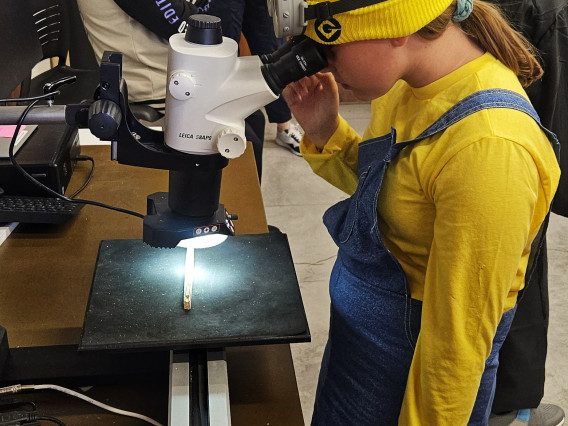Hendricks Elementary sixth graders engage with tree rings to connect science and society
Over three days in October, 75 sixth graders from Hendrick Elementary visited the Laboratory of Tree-Ring Research (LTRR) and took a deep dive into the world of dendrochronology, building on their classroom learning about tree rings, climate, and water use.
Before coming to the Lab, the students learned how tree rings reveal past climate conditions like temperature and rainfall in different biomes and about how they reflect the impacts of extreme events like fire and drought. At the LTRR, students experienced dendrochronology firsthand. They engaged with real tree core samples, and learned how scientists study these rings to uncover environmental history.
LTRR’s Dr. Pamela Pelletier worked with Crystal Shepard, 6th grade Science Teacher at Hendricks Elementary to create a laboratory visit with lesson plans that incorporate project-based learning (PBL) and the 5E model (Engage, Explore, Explain, Elaborate, Evaluate).
Using PBL and the 5E model offers a powerful approach to teaching dendrochronology, particularly when focusing on climate change, drought, and human impacts on the environment. By actively engaging students in real-world research—like analyzing tree rings to understand historical climate patterns—students develop critical thinking, collaboration, and problem-solving skills.
The 5E model scaffolds learning by guiding students through inquiry-based discovery, ensuring they grasp complex ecological relationships. Understanding what trees need to grow and how this influences ring growth led students to hypothesis about their tree cookie’s life experiences. Fire scars on the tree cookies were led to a discussion about other ecological processes trees might experience over their lifetimes and how those experiences may appear within the tree ring records.
Shepard said: "When students analyze tree rings firsthand, they step beyond textbooks into the living history of our plant - experiencing the thrill of discovery while honing critical scientific skills."
Students were surprised to learn that so many different fields of study could relate to dendrochronology. Evelyn S. said she enjoyed playing the Branching Out game to learn how different things are related to tree rings. Lily C said: “I thought that music and trees were not related to each other, but they it turns out… they are.”
Mia B. appreciated the hands-on aspect of the class, specifically “when we got to see the trees under the microscope, because it was cool and nice to see them up close”. Sophia S. said: “My favorite part of the class was when we observed the tree ring cookies. It is fun to observe different types of trees.”
Using paper core samples is an efficient technique to standardize the natural variation of ring widths between samples visually in order to date rings and create a chronology. Once students had the basics down, it was time to tour lab spaces and the archive.
The Archive was probably the biggest hit of the class. Cameron Q. said the best part was “the basement because it had all kinds of trees, and it smelled good in there”. He was surprised to learn that the LTRR has the biggest collections of trees in the world.
Back in the classroom, Pelletier taught about streamflow reconstruction using tree rings to study past droughts. Students had been exploring in their climate studies how the Colorado River’s water allocations have been affected by changing weather patterns over time. By understanding these natural cycles, students gain insight into how climate and water management impacts our environment.
Learning how these water sources support our community and the challenges of keeping water flowing in times of drought. Through hands-on activities and research, they are discovering ways to conserve and protect our precious water resources for the future.
Rylynn S. said that discussion about how water gets wasted would be a reminder to find ways to try to save water. Ayleen D. said she learned just how much “trees are very important for our environment”.
Shepard said: "Field trips like the Tree-Ring Lab transform learning into tangible adventure, fostering curiosity and connection that inspires my students far beyond the classroom walls."
The Hendrick’s sixth graders’ visit to the dendrochronology lab offered a dynamic blend of learning and exploration, bridging science with real-world environmental issues. Through an introduction to dendrochronology, they gained insights into how scientists use tree rings to uncover the history of climate conditions in various biomes. Comparing temperature and rainfall patterns and analyzing the effects of extreme events like fire and drought, helped students understand the interconnectedness of ecosystems. Class concluded with a hands-on role-playing activity where students debated and decided on water allocation, bringing home the relevance of these scientific concepts to pressing challenges like resource management and climate change. This immersive experience not only deepened their understanding but also empowered them to think critically about human impacts on the environment.




